Settling In: KTV
We were so busy walking around and exploring Rostock from the time we arrived until we moved to Gehlsdorf, that I didn't have time to do much note-taking, which means I've already forgotten some of the details. But I'll do my best to hit the highlights. We walked around a lot, mostly.
Our airbnb was in Kröperliner-Tor-Vorstadt (KTV for short) which is the hip college kid area apparently.
To give you some idea of the layout of Rostock, the Warnow River is an important feature. It meanders its winding way for nearly 100 miles on its journey northward from its source in southern Mecklenburg Vorpommern (or "Mecklenburg West Pomerania" in English, which is the Bundesland where Rostock is located.) By the time the Warnow reaches Rostock, it widens into a hook shaped harbor, sweeping west and then north where it finally spills into the Baltic at Warnemünde. All this to say that the city center and KTV are on the southern bank, while Gehlsdorf (where we are living now) is on the north bank.

This meant, that we had to take the ferry to view this apartment, in order to decide if we wanted to move in, which was quite an adventure. We walked around Gehlsdorf a bit while over here—it is definitely quieter on this side of the harbor—with fewer businesses and more single family homes. There are also a ton of sailboats over here!
In the afternoons and evenings, we would usually (as in every day) find ourselves at the harbor, which was only a few blocks from the KTV apartment. We would usually stroll up and down, and then nearly inevitably find ourselves at ROST DOCK which was really not much more than a collection of bright yellow shipping containers, where we drank many a bear/soda/coffee/water. It really was an ideal spot: overlooking the water we watched the sailboats, crew teams and paddle boarders cruise by, as well as a few bigger tour boats. It felt very fitting that Rost-Dock's last evening of the season was also our last evening in KTV. Adam suggested I put the majority of the no-caption needed photos in on a more viewer-friendly platform, so check out the link below for EVEN MORE photos, and read on for more context and some "translation needed" photos: https://photos.app.goo.gl/UDtmigJjMUVNu7Q19
Our rambling walks led us to the grocery store quite often where we found all the necessary ingredients for delicious Deutsche Früstuck. The key elements are: Fresh Brötchen (rolls) some good cheese, often some sort of sliced deli meat (if you like that kind of thing…) some sliced up fruits and veggies if you want, coffee or tea, sometimes a soft boiled egg, and to me most importantly: all of the available spreads. I do mean ALL available spreads—from pesto to gooseberry jam. This allows for some creative combinations, it's not just Nutella and butter, if you really get funky like I do, it's also honey with herbed sheep cheese, or mustard and tomato—whatever you want. Also at the grocery sore we found some actual champagne (like from that region in France!) for less than 5 Euros! A real wine connoisseur might have scoffed, but we were pretty excited.
Another day we found a lovely rose garden near the Steintor (stone gate) seen here with its impressive spire and imposing griffin guards.
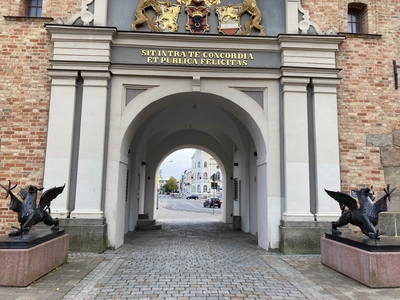
The latin apparently means "May harmony and prosperity reign within your walls" which is a nice sentiment, since it is on the site of what used to be the main southern entrance to what was at the time a walled city.
We managed to see some other fun things too, like the botanical garden:
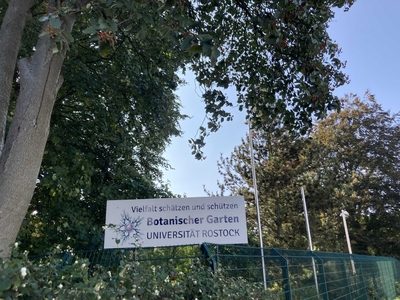
We had fantastic luck with the weather for the first two weeks actually—it was bright and sunny at least for part of most days, if not always that warm. On the warmest and sunnies day (it was almost 80) we decided to take the train to Warnemünde, which is the coastal area—technically still part of Rostock, but is a bit of a trek to get there. After a tram and a train and a bit of a walk we found ourselves on the baltic coast at last!
So we had a quick swim. It was still pretty cold, but not too salty, compared with the Atlantic certainly. We quickly realized that sinceI only had a small beach towel and Adam's was hand-towel sized, a lot of lazy beach-lounging wasn't really in the cards. So we strolled along the beach and then on to the peer where we peered at the lighthouses and boats going by. We eventually strolled back inland, along the canal where the Warnow river spills into the baltic, and tried our best to avoid bumping into the hordes of tourists. We'll have to go back when it's deeper into the off season and we can have the place more to ourselves.
One Saturday we toured Marienkirche (St. Mary's Church) which is the biggest church in Rostock. The original building was begun in 1230 (which blows my mind—the oldest buildings still standing in the US weren't built until two centuries later!)
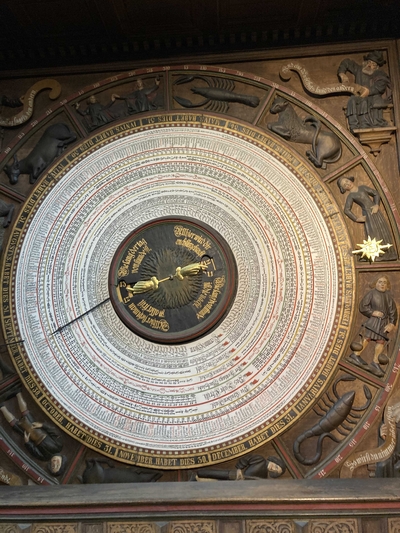
Amongst all the tourist-ing, I did manage to actually start school at Musikgymnasium Käthe Kollwitz Rostock. It is what we would call a music magnet school, that serves kids in grades 5-12, about half of whom are in the music program and half who are not. Adam and I met up with a couple of the teachers I had been corresponding with for coffee on Friday the 4th of September, and then I got a tour and started observing the English classes on Monday (when everyone was off work in the US for Labor Day, which is celebrated in May here) Things started off easily, as I just introduced myself and answered some general questions about myself and the US. The questions varied widely from "what is your favorite song/movie/show?" to "Is it true that McDonalds is better in the US?" There were also more serious questions about covid policy in the US versus Germany, the inevitable questions about Trump, and some well-thought out inquiries about gender-neutral pronouns, Black Lives Matter and the recent Texas abortion laws. All-in-all the students and teachers have been very friendly and welcoming as well as curious and eager to work with me, which certainly makes me look forward to the year and to leading more activities.
This sign in the bathroom made me chuckle at what a confusing mix of tones it conveyed: both cute and also so…passive aggressive? The translation would be "It is free to use the toilet brush!"
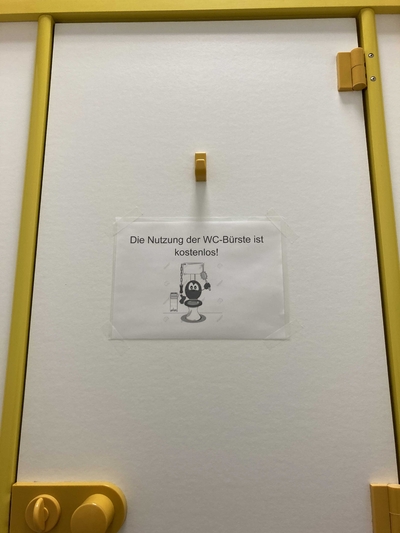
This is the mural on the gym building that is backed up against the path from the bus and tram stop. I like the musical-sportiness of it. The little ship icon on our guitar-playing (relay running?) musical athlete's shirt is the logo for the local soccer team: Fußball Club Hansa, which is a nod to the Hanseatic-League history of the city. The fans are VERY committed, and occasionally a bit over-the-top in their avid support, apparently. It was the most successful East German athletic team after unification, and although they have had a couple of rough years, this season seems to be off to a good start. We heard the cheering from the apartment when they beat Darmstadt with the home-team advantage.
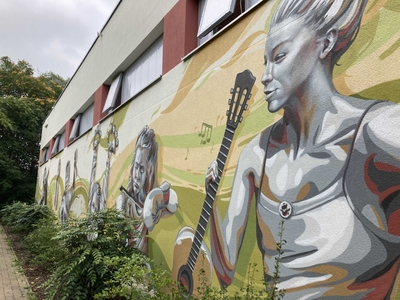
And now for some photos that don't fit in exactly anywhere above, but need some background explanation, so if I only put them on the google photos page they might not make sense…
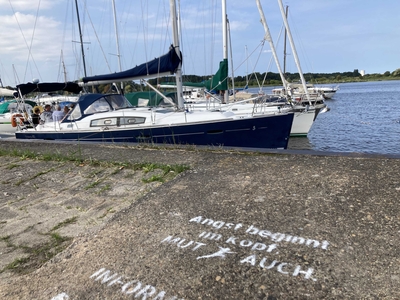
This next picture is a direct translation of the saying "Mehr Deutsch geht nicht" or non-literally translated "You can't get any more German than this" We found it in a craft beer store, so even though Adam was pretty horrified about buying one beer for 6 Euros, the language nerd in me had to get it.
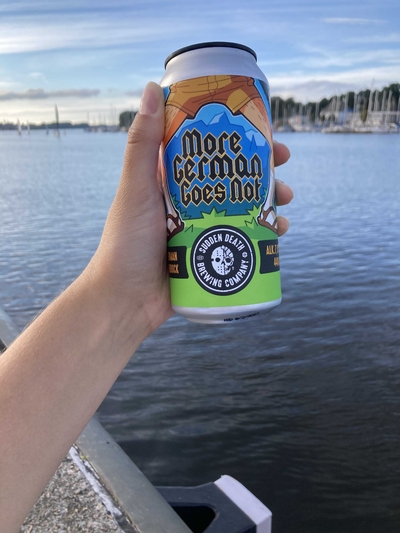
Why denote bathrooms with a boring stick figure or the same old words when you can just mark the separate stalls by how you do your business: either sitting only (that would be me!) or standing/sitting. It made me laugh, although I have never quite understood why single stall bathrooms need to be gendered at all….
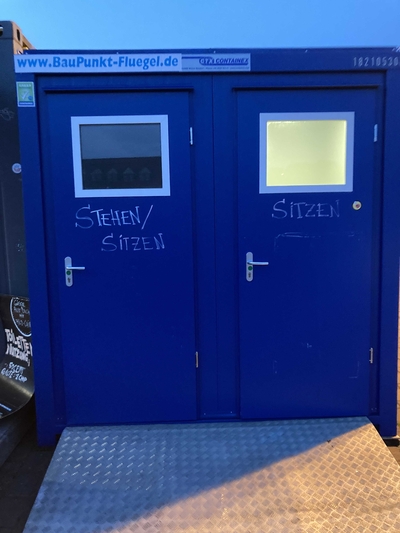
This is a sculpture outside of the Volksteater (people's theater) that was right near our KTV apartment.
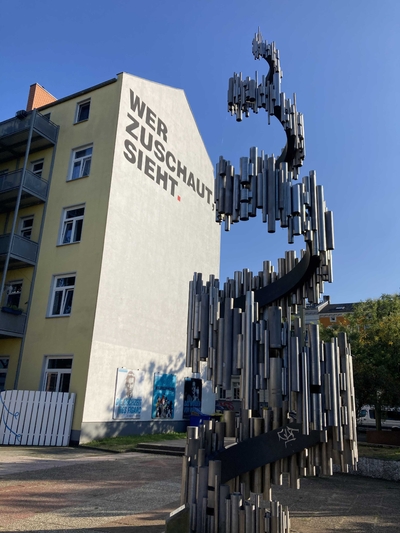
Anyone who looks, sees
So this will take some explaining if you don't speak German, but stick with me, it's funny. So the election happened recently (the 26th) and so there were campaign posters on every lamppost. One of the many parties is the "Tierschutzpartei" or the "the animal protection party" (trust German to have one word where we need 3!) Conveniently enough for this jokester, "Tier" (animal) and "Bier" (yep, beer) are just one little letter different, so now we have the "Beer protection party" because, as the sentence above points out "beer is important"
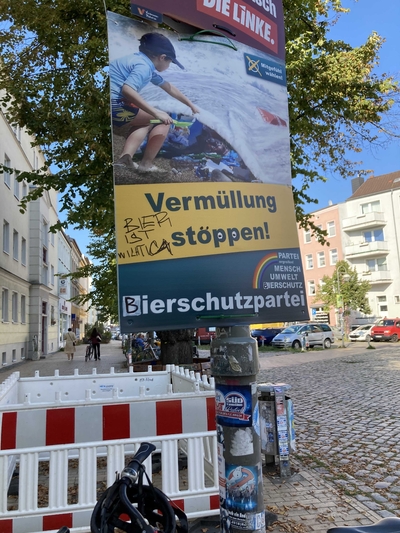
My Amplemann sticker finally got to reunite with his real light-up counterpart! "Ample" just means street light, but the Amplemann has become somewhat of a symbol of East Germany, since that is where this adorable little green fellow originates. His twin/alter/ego is red with his arms stretched out.
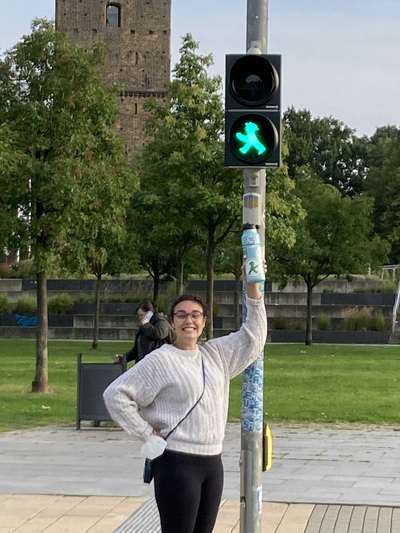
Who says you can't grow full-sized tomato plants on your windowsill? All you need is a tension rod, some beer crates and a bit of string!
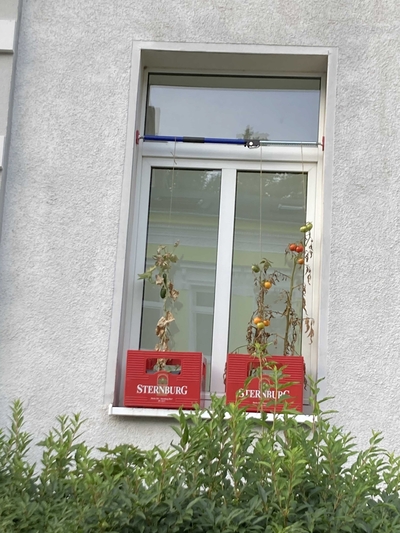
This modern shopping center, as well as our airbnb's neighborhood were named for the actual Kröpeliner Tor, which is the tall gate in the background. "Tor" means "gate" as in the famous "Brandenburger Tor" in Berlin. This one was built in 1270, and it served as the westernmost city fortifications of Rostock.
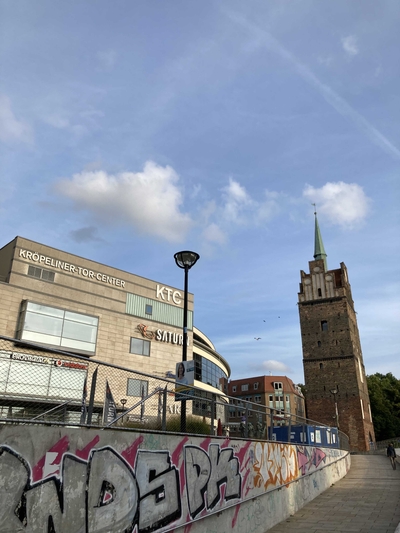
And that rounds off our headfirst dive into Rostock, folks! Thanks for sticking with me. I'll keep adding posts, and eventually hope to be less than a month behind where we actually are…next up: moving to Gehlsdorf! In the meantime, check out the link for more photos, if you're not sick of this yet: https://photos.app.goo.gl/UDtmigJjMUVNu7Q19
